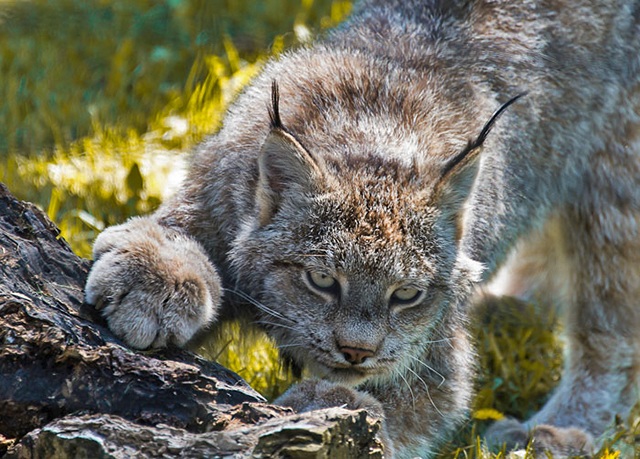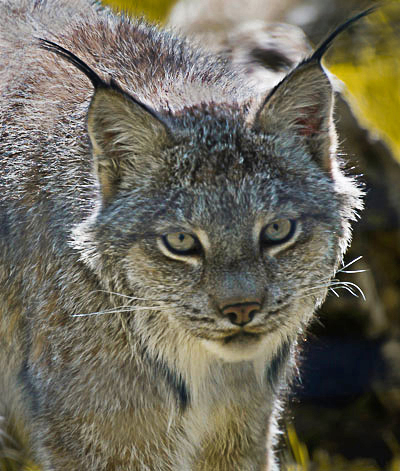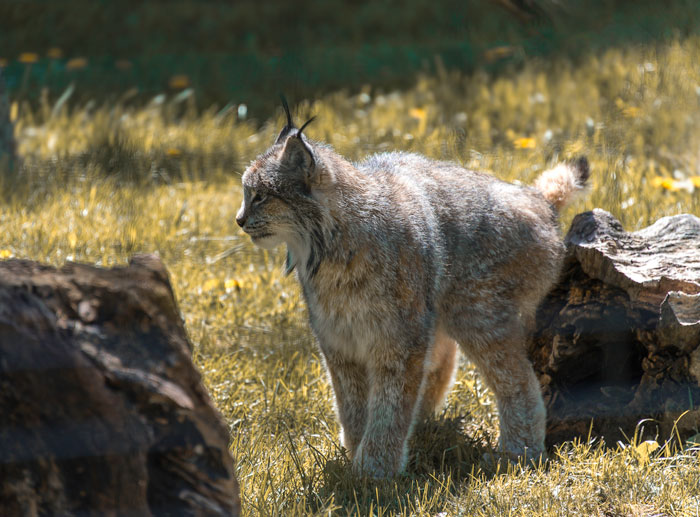.jpg)
© 2010 Michael Leggero. All Rights Reserved.
Grizzly Bear in Autumn
Glacier National Park, Montana
Nikon d300, 200-400mm f4, 1/60th, f5.6, ISO 200
Photographing dangerous animals is something that a lot of us adventurous photographers enjoy. It gets us excited when we are interacting with something that can have huge teeth, speed, claws, and power! Really, who is going to get an adrenaline rush by taking pictures of a cow?
As with many adventures in life, the more fun it is the more risky it can become, so I’m going to share some of the techniques I use to get closer to larger wild animals in order to get those great shots.
Lions and tigers and bears, oh my! Those are what everyone thinks about when they think of dangerous animals. And it’s true, they are dangerous! So, I’m going focus primarily on bears, since they are the most likely animal you will encounter on your own and then touch on the big cats within the U.S.
BEARS
This trip to Glacier National Park in Montana was in September and the bears were getting ready for hibernation. All they had on their minds was eating and building up fat for the winter.
.jpg)
© 2010 Michael Leggero. All Rights Reserved.
Grizzly Bear in Autumn
Glacier National Park, Montana
Nikon d300, 70-200mm 2.8, 1/250th, f2.8, ISO 200
Bears love berries, and if you found a big huckleberry patch then chances are a bear will be there sooner or later. Luckily, once they find the berry patch they don’t leave for a while. The bear is happy sitting there and eating for hours at a time. This is the safest way to work with these animals—when they are happy and content. Unless you do something very threatening, you usually won’t be bothered by them. Now, that is true for berries, but if you find them near a fresh kill things change drastically. Keep your distance, they will aggressively defend that kill and will see you as a threat.
In Glacier National Park you can often see bears from the roadside. The safest way to photograph these animals is to just drive by and then capture those images from within your car. However, by doing that, you will create a “bear jam”. Every car behind you will stop and suddenly there are 30 tourists with cameras making a lot of noise. But sometimes this can actually help. It will get the bear’s attention and he will often look around and even stand up to get a better view; good photo opportunities.
.jpg)
© 2010 Michael Leggero. All Rights Reserved.
Black Bear in Huckleberry Patch in Autumn
Glacier National Park, Montana
Nikon D300s, 600mm f4 with 2x teleconverter, 1/12oth, f8, ISO 200
Grizzly Bears (brown bears) are a bit more aggressive, and should be treated with a great respect. While black bears will use stealth and often run away when startled, grizzly’s are easier to find since they are less shy and may charge if startled.
Most of my experience with bears is with the black bear. Trust your senses; you can smell them if they are close to you. It’s a musty manure smell that’s suddenly in the area. These animals are wild and can injure you so pay attention.
Photographing these animals is lots of fun though. I recommend a long lens. The bigger the better, so it keeps you further away from them. When I am walking through the woods I usually have my 70-200, 2.8 ready and in my hand at all times. If you startle a bear while you are on a trail they will almost always run away. So be ready with that camera or all you’ll get is the backside of this big brown thing going through the bushes. Try to keep your shutter speed at 500th and aperture of 4 or 5.6 at the most. Smaller apertures will not blur the background and you will get a distracting image.
Your best opportunity… Bears don’t have very good eyesight, so if you know where the animal is you can sit and observe them, ideally with a long 400-600mm lens. Find a good spot, set up a tripod, sit still, and just watch him eat those berries. When you are comfortable and quiet you will get some great images. If you want to get his attention, don’t wave your arms or make big movements. That will usually scare him away. Simply use a whistle. One quick sound will make him look up, and if you are lucky, he will look right into your lens. Once he realizes that you aren’t moving towards him aggressively he will usually go back to eating.
.jpg)
© 2011 Michael Leggero. All Rights Reserved.
Grizzly Bear in Spring
Glacier National Park, Montana
Canon EOS 40d, ef100-400mm, 1/125th, f5.6, ISO 100
Now, if things go bad… Bear attacks are rare, but it always better to be safe than sorry. There are a lot of people out there with varying opinions on how to handle an aggressive bear. I’ve heard all the stories about what you should do, so just be has prepared as you can. Learn about the bears in the area you’re planning to visit, about bear behavior and what your various options are in case you encounter a bear. You can make loud noises and flap your arms and the bear often just runs away. There are also commercial bear sprays for sale at the national parks. Make sure that if you use bear spray it is not at the bottom of your pack and know that you have to be close to use it. Be sure you find out what the local laws are for an area and follow them. Now we all know that you shouldn’t look like prey and run, but if you forget that—just make sure you can run faster than your assistant! Ha-ha-ha!
BIG CATS
Photographing the big cats here in the U.S. is also very satisfying. Mountain lions, bobcat, and lynx are the most common. Again, if you want to capture images of them in the wild, learn all about their habitats and behaviors before you go out searching for them. Be prepared!

© 2012 Michael Leggero. All Rights Reserved.
Lynx in Adirondack Mountains, New York
Nikon D4, 28-300mm, 1/125th, f5.6, ISO 400
Mountain lions are very unlike bears because mountain lions will stalk you and hunt you as food! This is an animal that is very dangerous and requires advance planning and extra precautions. Mountain lions are very secretive animals and you will not be able to sneak up on them.

© 2012 Michael Leggero. All Rights Reserved.
Lynx in Adirondack Mountains, New York
Nikon D4, 28-300mm, 1/250th, f5.6, ISO 400
If you have the courage and determination to find them, talk to the locals, rangers and guides, as sometimes they will know where mountain lions live and can help you locate them. Then you’ll need to have a plan and be able to set up a place to work. This is a waiting game of patience.
Since I live in area where the big cats roam, I have that patience to wait. I’ll just get out the old camouflage coat and pants, go to an area where there have been sightings and sit in my hiding place. I set myself up in a safe place and make sure that I am well hidden and silent. I have never had the opportunity to see a mountain lion in the wild, but when I was out looking for more bears I saw a Lynx. Woo hoo! Another adrenaline rush!
If you have an adventurous nature and a passion for making wildlife images, and have done your homework and gained the necessary experience from others, then grab your camera, and enjoy the search.

© 2012 Michael Leggero. All Rights Reserved.
Lynx in Adirondack Mountains, New York
Nikon D4, 28-300mm, 1/250th, f5.6, ISO 400
In Part 2 we’ll trek out to capture some great images of bison, elk and moose.
Note from the Editor: Experience mean everything! If you are inexperienced with making images of dangerous wildlife, DO NOT go out looking for them! Do your research first and study so you can learn about their habitats and behaviors. Know what actions (warning signs) they may make that could indicate aggressive behavior. Go online, to your library, visit the U.S. Fish and Wildlife Service web site and always stop in at state or national park visitor centers and find out about the wildlife and current conditions in their area. In this case, knowledge means safety! To gain some experience, you may also want to considerate going out with an experienced wildlife workshop or tour company.
by Michael Leggero
All text & photos: © 2012 Michael Leggero. All rights reserved.

Leave a Reply